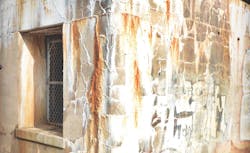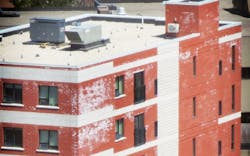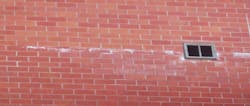Efflorescence Explained
Efflorescence is basically salt that has been pulled by water to the surface of brick or stone masonry. When the water evaporates, it leaves a white deposit that has a salty color and texture.
There are natural water-soluble salts in mortar and also some small amounts of salts from the clays that make up brick. When water gets into a brick wall, those salts can dissolve. Natural forces, such as the sun shining on the brick, pull the salt-laden water to the surface. The moisture evaporates into the air, leaving behind the salt.
A bit of discoloration on the surface is unsightly, but it doesn’t compromise the structure. However, if the salt is trapped just beneath the surface of the brick, stone, or block, it can cause further damage because the salt crystals will shrink and swell with wetting and drying cycles. That’s called subflorescence and, through repeated wet/dry cycles, it can create crystals large enough to cause the surface of the brick or stone to flake or spall off.
Rising Damp
When the wetting comes from rain, efflorescence and subflorescence are usually manageable. But when it comes from the ground, it’s more powerful because the ground will have an almost constant source of moisture.
Two forces are at work: capillarity and osmosis. Capillarity is the wicking of moisture due to surface tension. The pores in masonry are small enough that they create capillary suction that pulls water from the ground upward. Osmosis is a process by which areas with varying amounts of salt tend to equalize, with salt moving from places of greater concentration to those of lesser concentration. Once water is pulled into the masonry by capillary action, osmosis pulls salt out of the masonry and into the water.
Capillarity is affected by pore size—the thinner the tube in which the water can travel, the farther up the water can go. And because the little channels within masonry and mortar are quite small, the capillary action is strong. This doesn’t matter much high up on a brick wall. It gets hit with rain, but the water doesn’t penetrate that far and it evaporates before it attracts much salt. But it can get ugly where brick is in contact with the ground, particularly in a cold climate where a lot of salt is spread on sidewalks and driveways to melt ice in winter.
Why It Matters
Efflorescence and subflorescence can set up a vicious cycle because they can affect the durability of the brick itself. Brick has a very strong outer layer called a “fire skin,” which forms when the clay is fired in the kiln. If that fire skin gets damaged or completely disintegrates from the action of efflorescence and subflorescence, then that brick becomes more exposed. The inner body of clay, although strong in its own right, is softer and more porous than the fire skin and can wick up more water, which transports more salt. It’s like an efflorescence snowball effect.
Mortar is a key part of solving this snowball effect. Because it’s typically weaker than the brick around it, mortar is more prone to destruction by salt crystals. The calcium aluminates that make up the chemical composition of mortar are chemically bound and strong. But with excessive amounts of moisture, those bonds can break down, dissolving the salts and causing efflorescence. So one solution to saving brick from efflorescence is to use mortar that’s weaker than the brick. In this way, the mortar acts as a sort of sacrificial target that draws efflorescence away from the brick, but it’s a lot easier to replace or repair.
Another way to prevent efflorescence is to select brick that has a low salt content. That can be done at the factory, using tests to provide the correct formulation of brick. You can also use mortar with a low alkalinity—again, this can be tested to achieve the right formulation. Even so, as you mix the mortar with water, you want to make sure that it’s clean, potable water. You wouldn’t want to use seawater, for example, because seawater is saltwater.
Design Makes a Difference
Aside from choosing the best materials, design can go a long way toward solving efflorescence problems. A first step is to detail the wall assembly to protect the brick from exposure to rainwater. That means detailing ledges, roof caps, flashing, and window sills so they don’t get water directly resting upon them. Puddled water is more likely to work through the body of the wall and dissolve the salt. That’s why flashing is really worth its weight in gold; it helps collect and deflect water away from the wall.
To prevent capillary action from the ground, you can use a break between the bottom part of the wall and the rest of the wall. A flashing within the wall serves as a break so that rising damp doesn’t get pulled up to higher levels of the wall.
If you need to retrofit a brick wall, it’s difficult to install through-flashing at the base. In that case, break out the shovel and dig some soil away from that wall and put in gravel fill about a foot deep and a foot wide. Gravel doesn’t hold moisture very well, and if there’s no moisture in the soil, there’s nothing to get wicked up into the brick.
Efflorescence at the upper corner of the building (above) could be caused by repeated wetting and drying, or by air leakage from winter stack effect leading to condensation in the wall that travels through the brick. Efflorescence around the vent (below) is caused by air leakage; in the wall joint, it’s related to poor drainage through the wall flashing. Photos: Sarah Gray, courtesy RDH Building Science




